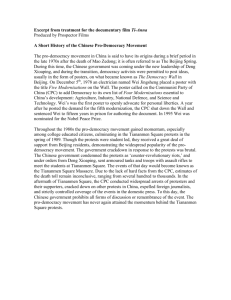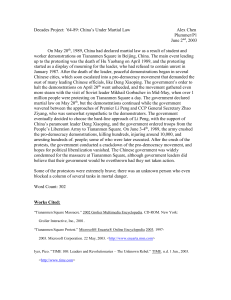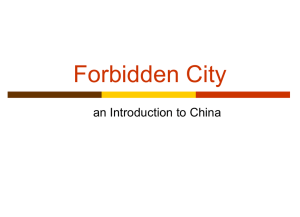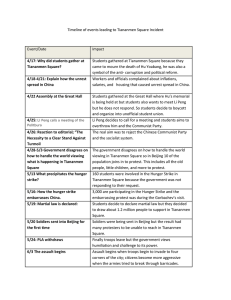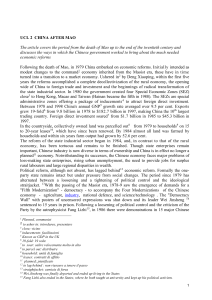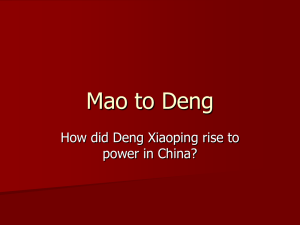2013 Tiananmen Square Massacre Powerpoint
advertisement
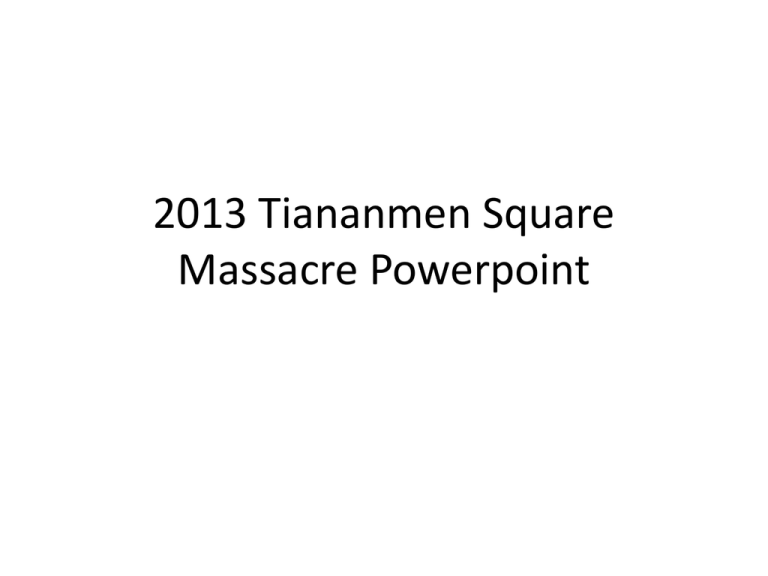
2013 Tiananmen Square Massacre Powerpoint Background Info • China operates under a “Communist” government: meaning that people have limited rights and freedoms. • The government controls all information, including: books, radio, media, news, television, etc. • The government also controls people’s jobs and how much they are paid. Background Information • By 1980 Deng Xiaoping emerged as the powerful communist leader in China • He implemented the Four Modernizations which called for progress in agriculture, industry, defense, and science and technology • Deng’s economic reforms increased food production, gave more freedom to industry managers, increased incomes, increased consumption, and opened doors for Western technology and style Causes of the Protest • However, the gap between the rich and poor widened • Chinese officials began accepting bribes and enjoying privileges others did not have • The new policies also opened doors for Western political ideas • Chinese students began studying the West and began questioning China’s lack of political freedom Causes of Protest • Deng Xiaoping, China’s ruler sent many Chinese students to foreign universities to improve China’s economy and to gain capitalist values. • Instead of gaining a sense of capitalist values, the students picked up democracy ideals and other western ideologies. Cause of Protest: Inflation • There were many university students and others in China who wanted political and economic reform. • There was a lot of price inflation and corruption by government officials. • Inflation was at an astounding 18.5 percent in 1988 because of panic withdrawing and buying on rumors of what relaxing price controls would mean • Student-led demonstrations calling for more individual rights and freedoms. Causes of Protest: Bank System • Banking System Cracks. • In the late 80's Chinese banks flooded the market with loans. • As could be expected, a great deal of them went bad and an estimated 1/3 of factories were unprofitable. • The government brought this to an abrupt halt in 1988 by cutting the cash flow -- a kind of austerity measure many didn't take too kindly to. Causes of Protest: Corruption • There was always corruption in the PRC, but Reform & Opening Up made it much easier and much more visible. • In the 80's, many price controls were lifted, but not all. • The shortages of some goods allowed people with the right connections to buy at the artificially low prices and sell at market rates for huge windfalls. • So naturally, the already-powerful became even more powerful. • The inequality of opportunity and obvious abuse of power were two things immediately visible to those affected and were direct causes the Tiananmen protests. Cause of Protest: The Media • The Chinese media of the 1980's covered issues that had never been touched in the PRC previously; even dabbling in corruption cases. • Single essays or TV programs could stir up fiery political discussion on college campuses. • A documentary called River Elegy played on CCTV in 1988, which subtly criticized Chinese culture and sparked nationwide debate. • When the protests themselves started, the press covered them extensively and even portrayed the student protestors sympathetically. • These factors shined a light on many issues intellectuals were concerned about and brought together like-minded activists Causes of Protest: Education Failure • After the Cultural Revolution, universities re-opened and were a sure ticket to a better life. • However, with further reform and opening of the markets in the mid-to-late 80's, many college students graduated to find their education gave them no real advantage in the new business landscape. • In 1988, the system that assigned college graduates jobs was also amended • To where private companies could reject those top students assigned to them in favor of those who had connections inside the company. Causes of Protest Competing Communist Party Members • In the lead up to Tiananmen there was an obvious rift in the party between progressives like Zhao Ziyang and Hu Yaobang and hardliners like Li Peng. • This rift was absolutely apparent in the days leading up to the crackdown. • The protestors saw this split and sniffed weakness; which emboldened them further Cause of Protest: Competing Communist Members • Hu Yaobang is a government official who called for more freedom and “Democratic Reforms.” • Other Chinese officials are outraged and force him to resign from his job. • Students in China are influenced by Yaobang’s calls for freedom, and follow his cause. Hu Yaobang Causes of Protest: Hu Yaobang Dies • On April 15th, 1989 – Hu Yaobang dies • Students begin a rally in Tiananmen Square to mourn his death. • The government tries to disperse the crowd – only fueling more anger and unrest. • Students begin to protest the harsh rules of the government, and call for democratic reforms. Cause of Protest: Hu’s Death • The death of Hu in the spring of 1989 started the chain of events. • After he died, many Dazibaos, which are big character newspapers or wall posters with political messages were placed throughout college campuses. • These posters called for more economic and democratic reforms. • Hu became a martyr for the cause of political liberalization. • On April 22, which was the day of Hu’s funeral, tens of thousands of students gathered in Tiananmen Square. • The students demanded democratic and other reforms. • It began on April 15, 1989. Hu Yaobing, a Chinese leader who had been fairly tolerant of student demonstrations in 1986, died. • Students in Beijing mourned his passing by meeting in Tiananmen Square and voicing their grievances. The Protest Begins • For seven weeks in the spring and early June 1989, Chinese students and citizens took over Tiananmen Square in Beijing, calling for reforms and greater freedom. • It seemed for a while that revolution was coming to China. The Protest Begins • Workers and other Chinese join the protest with the students. The Protest Begins • The students gathered at Tiananmen Square in Beijing, China to take part in pro- democracy demonstrations. • Then there was a large military crackdown because Deng Xiaoping didn’t want the communist government to be threatened or influenced by democratic ideals. The Protest Begins • Over the next several weeks: • Crowds of students gathered in Tiananmen Square. • They were seeking political, social, and economic reform. • Initially the government issued warnings without taking any action against the crowds. Tiananmen Square, 1989 More democracy! Tiananmen Square, 1989 Student activist, Wang Dan, Beijing University Tiananmen Square, 1989 Democracy—Our Common Ideal! Chinese Government’s Initial Responses to Protest • Zhao Ziyang addressed the demonstrators offering concessions. • Li Peng and Deng Xiaoping both feared anarchy, so they insisted on forcibly suppressing the protests. • Martial law was declared in Beijing, and army troops started going around the city. Beijing citizens flooded the streets to block the soldiers. • The protesters remained in large numbers in Tiananmen Square. Government’s Initial Responses • On April 26, The Communist Party newspaper People's Daily accused “an extremely small number of people with ulterior purposes” of inciting the students to unrest in order to overthrow the Communist government. • There were warnings to students that force might be used. • This file photo taken on June 3, 1989 shows a dissident student asking soldiers to go back home as crowds flood into central Beijing Tiananmen Square, 1989 Student Leaders Are Arrested Martial Law Declared • The next day students from more than 40 universities demonstrated in Tiananmen Square to protest the editorial. • They were joined by thousands of citizens. • The square was occupied by pro-democracy demonstrators until June 4. • On May 13, 3,000 students began a hunger strike. • On May 17 more than a million citizens and students were demonstrating in Beijing. • On May 20 martial law was declared. • The army came to Beijing and was stopped by citizens who blocked their path with barcaroles. • Initial attempts of the People's Liberation Army to remove the demonstrators failed. The Military Beating The Protestors Tiananmen Square, 1989 The Army Looks for Dissidents • In this file photo from May 30, 1989, a student from an art institute plasters the neck of a replica of New York's Statue of Liberty dubbed the Goddess of Democracy in front of the Great Hall of the People (right) and the monument to the People's Heroes (center) to promote the pro-democracy protests against the Chinese government at Tiananmen Square in Beijing Students Respond By: • On May 30, demonstrators erected the Goddess of Democracy in the square, made in 4 days out of plaster. It was inspired in part by the Statue of Liberty. • On June 1 the government cut off access to foreign journalists. • On June 2, 6 convoys of tanks and soldiers moved toward central Beijing. • All were stopped by citizens, often physically blocking the path of the tanks. Tiananmen Square, 1989 The “Goddess of Democracy” • On June 2, 2009, three Chinese dissidents, from left to right, Yu Zhijian, Yu Dongyue and Lu Decheng pose beside a photograph of the defaced Chairman Mao portrait, which they had pelted with dyefilled eggs during the 1989 Tiananmen Square democracy movement, in Washington, June 2, 2009. • The three men spent much of the past 20 years behind bars for marring the massive portrait at Tiananmen Square, and today say that the students who led that movement have failed to continue the struggle. • A file photograph from June 3, 1989 shows a dissident student (left) shouting to soldiers, asking them to go back home as crowds flood into central Beijing ahead of the army's crackdown on prodemocracy protests. Government’s Actions Prior To Massacre • June 3-4: • The Chinese government arrested thousands of suspected dissidents. • Many received prison sentences of different lengths of time, and many were executed. The Massacre • It happened on June 4, 1989. • There was a large number of military soldiers, vehicles, and tanks that were brought in to stop the protests. Tiananmen Square, 1989 The Government Clamps Down • An armoured personnel carrier crushes one of the tents set up on Tiananmen Square by pro-democracy protestors early Sunday morning in this June 4, 1989 file photo • This file photo taken on June 4, 1989 shows an armoured personnel carrier in flames as students set it on fire near Tiananmen Square in Beijing. • A captured tank driver is helped to safety by students as some in the crowd beat him in this June 4, 1989 photo in Beijing The Massacre Begins • Tanks and armored personnel carriers moved toward the square. • Demonstrators were attacked with tear gas, rubber bullets and electric truncheons. • Soldiers opened fire on those attempting to block their progress. • By midnight the tanks had reached the square. • This June 4, 1989 photograph shows a girl, wounded during the clash between the army and students near Tiananmen Square in Beijing being carried out by a cart. • This file photo taken on June 4, 1989 shows Beijing residents inspecting some of over 20 armoured personnel carriers and other vehicles burnt by demonstrators to prevent the troops from moving into Tiananmen Square in Beijing. • This file photo taken on June 4, 1989 shows Beijing residents inspecting the interior of one of the armoured personnel carriers burnt by demonstrators to prevent the troops from moving into Tiananmen Square in Beijing • On June 4, troops opened fire on the crowd. 2,600 were estimated dead and 10,000 injured. • 500 tanks and 300,000 soldiers occupied Beijing. • In this photo taken on June 5, 1989 and made available for the first time by the AP on Thursday June 4, 2009, three unidentified men flee the scene, as another man (background left) stands alone to block a line of approaching tanks (background right) in Beijing's Tiananmen Square. • This previously unseen photograph was taken by then-AP reporter Terril Jones and came to light after online discussions of the incident on The New York Times' Lens Blog on the 20th anniversary of the Tiananmen Square crackdown. • This photo from June 6, 1989 shows People's Liberation Army (PLA) tanks and soldiers guarding the strategic Chang'an Avenue leading to Tiananmen Square in Beijing two days after their crackdown on prodemocracy students Tank Man • His identity is unknown. • He stood in front of a line of tanks to stop them from moving forward. • The convoy tried, to move around him, but the Tank Man kept moving in front of them. • It was said that he climbed up on the leading tank and talked to the driver. • He was believed to have asked why the tanks were there, and that they were harming the city. Tiananmen Square, 1989 One Lone Man’s Protest The Symbolism of “Tank Man” He was a normal & brave man He fought for what he believed in Tank Man shows that anyone can stand up to injustice Incredibly bold No one knows what happened to him Tiananmen Square, 1989 The Massacre: The People’s Army Moves In The Massacre It was being filmed in a hotel People on bicycles were begin shot People were crying and soldiers struck them with batons Women were holding their bloody heads Everywhere people were running & fleeting Tiananmen Square, 1989 The Massacre: A Human Body Crushed by an Army Tank The Massacre and Aftermath • Wang Dan in 1989 Tiananmen Square was followed by a period of repression marked by mass arrests and executions. • Thousands were jailed, harassed and threatened. • Some were executed, shot in the back of the neck, and photographs of the bodies were posted all over the country as warnings. • One girl leapt from a 12th story window because she was "depressed in the atmosphere of recrimination." Casualties o There were many different ranges of tolls o 200- 300 (Chinese Government) o 400- 800 (The New York Times) o 2,000- 3,000 (Chinese student associations and The Red Cross) o No exact statistics for death tolls were given o There can be different biases seen here. Aftermath of Massacre • Deng ordered 250,000 thousand troops to surround Beijing • On June 4, 1989 the standoff ended with thousands of armed soldiers and tanks storming Tiananmen Square • The assault killed hundreds and wounded thousands • Tiananmen Square began a campaign to detain protesters • Police arrested about 10,000 people and used media to cover up the assault in Tiananmen Square • Campaign left Deng firmly in control of China, however in 1997 Deng died and Jiang Zemin became the Communist Party leader • After the massacre, a student leader said, "The government has won the battle here today. But they have lost the people's hearts." Aftermath of Massacre George Bush said, “I deeply deplored the use of force.” The ferocity of the attack took many by surprise This did not result in a radical change in the Chinese government After China had tightened their government This event became more conservative around the world Tiananmen Square, 1989 Chinese Students Mourn the Dead Tiananmen Square, 1989 The Reestablishment of Order Poetry on Tiananmen Square Massacre • James Fenton, journalist, poet and university professor, wrote Tiananmen in China 10 days after the 4 June Tiananmen crackdown in 1989. • Tiananmen is Beijing’s main square, and is surrounded by key civic buildings. • Tiananmen literally means ‘Heaven’s Gate’. Tiananmen by James Fenton, 15 June 1989 Tiananmen Is broad and clean And you can’t tell Where the dead have been And you can’t tell What happened then And you can’t speak Of Tiananmen. You must not speak You must not think. You must not dip Your brush in ink. You must not say What happened then, What happened there In Tiananmen. The cruel men Are old and deaf Ready to kill But short of breath And they will die Like other men And they’ll lie in state In Tiananmen. They lie in state. They lie in style. Another lie’s Thrown on the pile, Thrown on the pile By the cruel men To cleanse the blood From Tiananmen. Truth is a secret. Keep it dark. Keep it dark In your heart of hearts. Keep it dark Till you know when Truth may return To Tiananmen. Tiananmen Is broad and clean And you can’t tell Where the dead have been And you can’t tell When they’ll come again They’ll come again To Tiananmen. How Did The United States Respond • In the United States, President Bush cancelled all shipments of military ports to China and extended all visas of Chinese student studies in the United States. • Bush extended all visas because he knew that no student who entered back into China would be able to continue their studies because of the protests. • He also cancelled shipments of military equipment because he wanted to end the fighting between the Chinese soldiers and the protestors. How The World Responded • Many countries gave China the cold shoulder and the United States granted asylum to anyone who claimed involvement in the Tiananmen Square incident. • Richard Baum of the Center of Chinese Studies at UCLA told the Los Angeles Times, “The whole incident was a public relations disaster for Beijing, the effects of which continue to this day. It has cost the Chinese government enormously, not just in terms of sanctions and abuse accusations abroad...but in the government’s reputation as being the Butchers of Beijing. “ Dalai Lama’s Response • The Dalai Lama of Tibet, advocate for nonviolence, winner of the Nobel Peace Prize, and spiritual leader of the Tibetan people, spoke on the occasion of the 6th anniversary of Tiananmen Square: • “One of the most encouraging, moving and hopeful events in the recent Chinese history has been the democracy movement of 1989. The world had a rare opportunity to see the human face and spirit of China. Millions of Chinese brothers and sisters displayed openly and peacefully their yearning for freedom, democracy and human dignity. Although they had been born and raised under the slogan that "power grows out of the barrels of guns", they embraced nonviolence in a most impressive way reflecting the values for which the movement stood. “ Denials By Chinese Government • The Chinese authorities still refuse to recognise the 1989 pro-democracy protests as a legitimate exercise of the rights to freedom of expression and assembly. • Dozens of protestors arrested in June 1989 remain in prison. • Conversely, the people who committed human rights abuses against the protestors have never been held accountable. Hiding The Truth • After Tiananmen Square, freshman at several universities in Beijing and Shanghai were sent away for Cultural-Revolution-like reeducation and universities offered ideology classes that taught the governments version of the events. • Eulogies for senior party members usually included a praise for their "clear stand" on Tiananmen. Hiding The Truth • The Chinese authorities have done everything possible to • erase the events of 1989 from history: • If you type “Tiananmen Square” into a search engine in China, you are unlikely to find any information relating to the pro-democracy protests of 1989 • You’ll find no mention of the demonstrations in official Chinese magazines, newspapers or school text books • Many young Chinese people are unaware that the crackdown took place • Anyone who tries to draw attention to it puts themselves, their families and their friends at risk Hiding The Truth • In China, discussion of the event is considered inappropriate • The government blocks all information on the internet such as Google or Wikipedia • There are no news reports on the subject China After Deng • Jiang had questions surrounding him about what kind of leader he would be • Jiang faced challenges from rivals who wanted to divert away from Deng’s economic policies • During 1990’s the U.S. pressure China to release political prisoners and ensure basic human rights • China resisted the pro-democracy movement but the desire for freedom still ran through Chinese society • In 1997, Jiang paid a visit to the U.S. and protesters demanded democracy in freedom • Jiang admitted that China made mistakes but refused to promise a change in China’s political policies • To this day China still remains a communist government What’s the Message Here? Memorial in Warsaw, Poland

